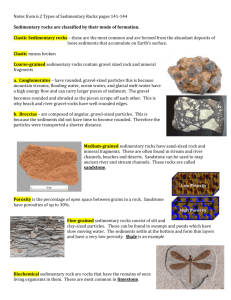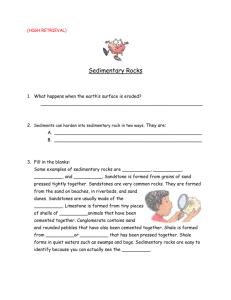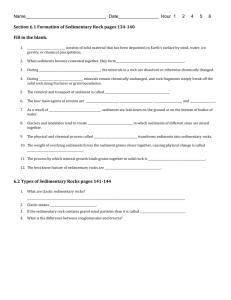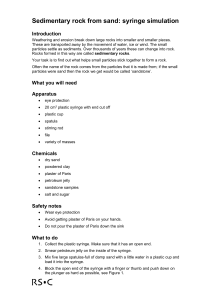Sedimentary rock from sand: syringe simulation: teacher`s notes
advertisement
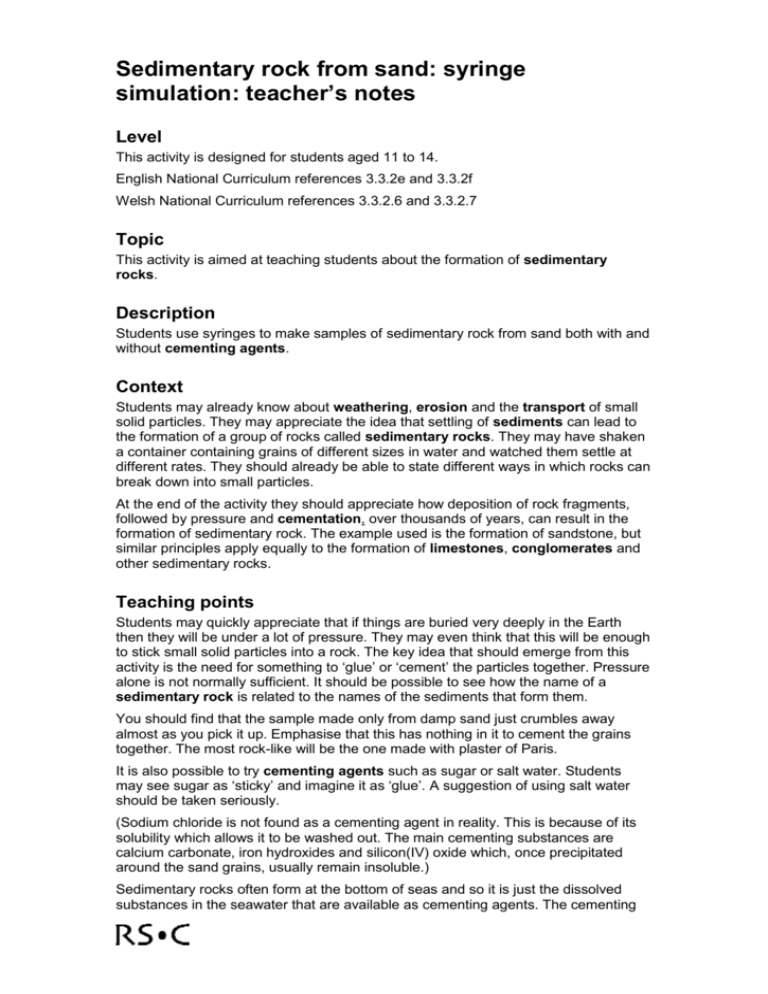
Sedimentary rock from sand: syringe simulation: teacher’s notes Level This activity is designed for students aged 11 to 14. English National Curriculum references 3.3.2e and 3.3.2f Welsh National Curriculum references 3.3.2.6 and 3.3.2.7 Topic This activity is aimed at teaching students about the formation of sedimentary rocks. Description Students use syringes to make samples of sedimentary rock from sand both with and without cementing agents. Context Students may already know about weathering, erosion and the transport of small solid particles. They may appreciate the idea that settling of sediments can lead to the formation of a group of rocks called sedimentary rocks. They may have shaken a container containing grains of different sizes in water and watched them settle at different rates. They should already be able to state different ways in which rocks can break down into small particles. At the end of the activity they should appreciate how deposition of rock fragments, followed by pressure and cementation, over thousands of years, can result in the formation of sedimentary rock. The example used is the formation of sandstone, but similar principles apply equally to the formation of limestones, conglomerates and other sedimentary rocks. Teaching points Students may quickly appreciate that if things are buried very deeply in the Earth then they will be under a lot of pressure. They may even think that this will be enough to stick small solid particles into a rock. The key idea that should emerge from this activity is the need for something to ‘glue’ or ‘cement’ the particles together. Pressure alone is not normally sufficient. It should be possible to see how the name of a sedimentary rock is related to the names of the sediments that form them. You should find that the sample made only from damp sand just crumbles away almost as you pick it up. Emphasise that this has nothing in it to cement the grains together. The most rock-like will be the one made with plaster of Paris. It is also possible to try cementing agents such as sugar or salt water. Students may see sugar as ‘sticky’ and imagine it as ‘glue’. A suggestion of using salt water should be taken seriously. (Sodium chloride is not found as a cementing agent in reality. This is because of its solubility which allows it to be washed out. The main cementing substances are calcium carbonate, iron hydroxides and silicon(IV) oxide which, once precipitated around the sand grains, usually remain insoluble.) Sedimentary rocks often form at the bottom of seas and so it is just the dissolved substances in the seawater that are available as cementing agents. The cementing agents in sedimentary rocks must have formed from minerals that crystallise from solutions that were around the particles. Pressure squeezes out the water (or air) and leaves the cementing particles behind. Timing One lesson of about 50 minutes should be enough for an introduction and the practical work. Follow up work will be needed the following lesson but do leave enough time for the ‘rocks’ to dry out (it is best allow two days if possible). The link to the next lesson will be testing the ‘rocks’ and then relating this to timescales of rock formation, possibly describing some properties of sedimentary rocks and perhaps looking at other sedimentary rocks. Apparatus Each student (or group) will need eye protection a 20 cm3 plastic syringe with the end cut off, this is best done by the technician beforehand plastic cups for mixing spatulas stirring rods a file a variety of masses Chemicals Each student (or group) will need dry sand, sharp sand is best, about 100g per student powdered clay, about 10g per student (use a cheese grater to grind up dried out clay from the art department) plaster of Paris (irritant), about 10g per student sugar and salt if these are to be attempted, about 10g per student petroleum jelly samples of sandstone Safety notes Wear eye protection. Avoid touching plaster of Paris. It is an irritant. Make sure no-one puts plaster of Paris down the sink. The sink will block. Care will be needed if the ‘rocks’ are tested using the idea of dropping masses on them. It is the responsibility of the teacher to carry out an appropriate risk assessment. Extensions To add some realism try the effect of including some iron(III) hydroxide gel in each mixture. The products will be much darker and this can be linked to the increased iron content in ‘red sandstone’. It may also bring out the fact that there are a lot of iron(III) compounds in rocks and that this causes rocks to take on a darker ‘rusty’ colour. Iron(III) hydroxide gel can be made by adding a few drops of 0.1mol dm-3 sodium hydroxide solution to a solution of iron(III) chloride. If pale sand is used to start with the ‘sandstone’ formed will be much darker when Fe3+ ions are present. This is similar to the conditions prevailing when this type of red sandstone was formed 350 million years ago. The point that could be brought out is that the conditions at the time of deposition affect the nature of the rock formed (but this is really for students 14 to 16). Answers to questions Q 1. Mudstone or shale (shale is a mud-rock with very closely spaced layers in it: mudstone is more ‘chunky’). Q 2. When sediments are placed under pressure (by other sediments above them), any water or air is squeezed out. Mud contains a lot of water - when all of this is squeezed out, the particles that remain will have been greatly compressed. Sand grains hold less water between them than mud particles. When the sand is compressed there is less water to squeeze out and so the overall volume of the sediment will not be reduced so much. Q 3. Sandstone B is best. Acid rain would attack the calcium carbonate cementing agent in sandstone A and this would cause weakness in any building made from it.

